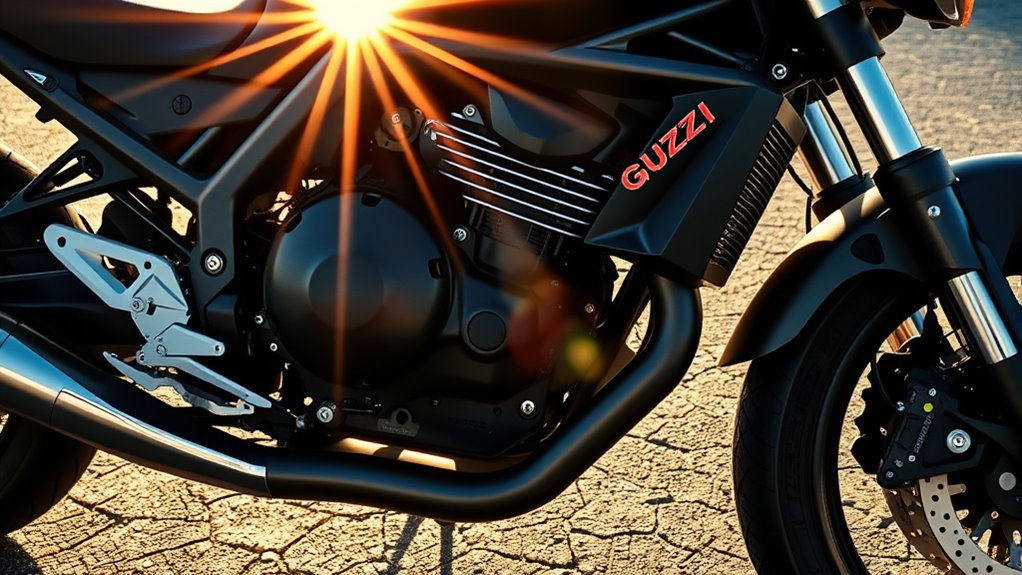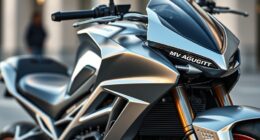Moto Guzzi tackles extreme heat with a smart mix of oil cooling and careful airflow management. Their oil cooling system circulates oil through dedicated passages to absorb heat efficiently, preventing engine overheating. At the same time, they design bodywork and strategically place vents to maximize natural airflow around the engine, carrying away excess heat. This combination keeps your engine running smoothly and reliably even in scorching conditions. Keep exploring to discover more about how these strategies work in detail.
Key Takeaways
- Moto Guzzi employs oil cooling systems to efficiently dissipate heat and prevent engine overheating in extreme temperatures.
- They strategically design airflow management, including vents and radiator placement, to enhance passive cooling.
- Combined use of oil cooling and optimized airflow ensures consistent engine performance under high-heat conditions.
- Their cooling strategies minimize hot spots and maintain engine temperature within safe limits during intense riding.
- These advanced cooling methods enhance durability, reliability, and rider confidence in extreme heat environments.

Moto Guzzi has developed innovative cooling strategies that guarantee ideal engine performance and durability. When riding in extreme heat, maintaining optimal engine temperature becomes crucial, and Guzzi’s approach ensures your bike stays reliable even under intense conditions. One key aspect of their strategy is a sophisticated oil cooling system. Unlike traditional air-cooled engines, Moto Guzzi integrates oil cooling to dissipate heat efficiently. The engine oil, which lubricates and cools vital components, is circulated through dedicated cooling passages or radiators, absorbing heat as it flows. This process prevents the engine from overheating, especially when ambient temperatures soar. By controlling oil temperature precisely, Guzzi helps preserve engine integrity, reduces wear, and keeps performance consistent. You’ll notice that during long, hot rides, the engine remains stable and responsive, thanks to this dedicated oil cooling system. Additionally, monitoring refrigerant levels and ensuring proper airflow can further enhance cooling efficiency, especially in extreme heat conditions. Alongside oil cooling, airflow management plays a vital role in Moto Guzzi’s cooling strategies. The design of the motorcycle’s bodywork, vents, and radiator placement is meticulously engineered to optimize airflow around the engine. When you accelerate, air flows naturally through these channels, carrying away excess heat. This passive cooling method is enhanced by strategic placement of air intakes and outlets that maximize airflow efficiency. You might feel the difference when riding through a hot environment, as the bike’s design actively promotes cooling without requiring additional fans or pumps. Guzzi’s focus on airflow management ensures that even in extreme heat, hot spots are minimized, and the engine’s temperature remains within safe limits. This dynamic airflow also contributes to better fuel efficiency and overall engine performance. Together, oil cooling and airflow management form a comprehensive cooling system that adapts seamlessly to challenging conditions. You benefit from a motorcycle that maintains peak performance, whether you’re cruising through scorching deserts or tackling mountain passes on a hot day. Moto Guzzi’s engineering ensures that heat dissipation is efficient, reducing the risk of overheating and mechanical failure. You don’t have to worry about the engine running hot; instead, you can focus on your ride, confident that the cooling system is working tirelessly behind the scenes. In extreme heat, this combination of oil cooling and airflow management demonstrates Moto Guzzi’s commitment to durability, performance, and rider confidence, keeping your motorcycle running smoothly no matter how high the temperature climbs.
Frequently Asked Questions
How Does Ambient Temperature Affect Moto Guzzi’s Cooling Efficiency?
Ambient temperature directly impacts your Moto Guzzi’s cooling efficiency, as higher temps reduce heat dissipation. You’ll notice that ambient airflow becomes vital—adequate airflow helps carry away heat. Additionally, radiator placement matters; if it’s positioned where airflow is restricted, cooling suffers. On hot days, make certain your radiator has good airflow and is unobstructed, so your bike runs cooler and maintains ideal performance despite the high ambient temperature.
Are There Specific Maintenance Routines to Enhance Cooling Performance?
You should regularly check your coolant levels, make sure the coolant is fresh and topped up, and clean the radiator to remove dirt and debris. These routines help maintain ideal cooling performance, especially in extreme heat. Additionally, inspect hoses for leaks or cracks, and replace the coolant according to your motorcycle’s schedule. By staying proactive with coolant checks and radiator cleaning, you keep your Moto Guzzi running cool and prevent overheating.
What Are the Signs of Overheating in Moto Guzzi Motorcycles?
You’ll notice your Moto Guzzi overheating when the engine temperature rises rapidly or if the temperature gauge hits the red zone. Be alert for coolant leaks under your bike, as they indicate cooling system issues. You might also feel increased engine noise, a loss of power, or even a burning smell. Ignoring these signs can lead to serious damage, so check your coolant levels and keep an eye on engine temperature regularly.
Do Different Moto Guzzi Models Have Varying Cooling Requirements?
You might think all Moto Guzzi models have the same cooling needs, but they actually vary due to model-specific cooling and design adaptations. For instance, larger touring bikes often require more robust cooling systems, while smaller models may rely on simpler setups. These differences guarantee peak performance across diverse riding conditions. So, pay attention to your specific model’s cooling requirements, especially in extreme heat, to keep your bike running smoothly.
How Do Aftermarket Modifications Impact Cooling in Extreme Heat?
Aftermarket modifications can substantially impact your bike’s cooling in extreme heat. By adding aftermarket cooling components or custom heat management solutions, you can improve heat dissipation and keep your engine running smoothly. However, poorly installed or incompatible upgrades might restrict airflow or disrupt existing cooling systems. Always choose high-quality aftermarket cooling parts and guarantee proper installation to maintain ideal performance and prevent overheating during extreme conditions.
Conclusion
You now know how Moto Guzzi tackles extreme heat with innovative cooling strategies. Did you know that their air-cooled engines can operate efficiently even at temperatures exceeding 100°F? This remarkable feat shows their commitment to durability and performance. So, next time you ride in scorching weather, remember that Moto Guzzi’s clever cooling techniques keep your bike running smoothly, ensuring you stay cool and confident on every ride.









